- What is limescale?
- How often should you clean your kettle?
- How to descale your kettle
- Cleaning the outside of your kettle
- Preventing limescale buildup in the future
Editor's Note: This post was originally posted in March 2021 and has been completely revamped and updated for accuracy and comprehensiveness in March 2023.
Hot beverages, porridge, and hot water bottles - we use our tea kettles more than we realise! If you think you can get away without knowing how to clean a kettle, you're wrong. Just take a peek inside the lid to see what horrors are lurking at the bottom!
If you don't keep up with kettle maintenance on a regular basis, it won't boil as quickly and could even end up breaking over time. It's better for the environment - and your bank balance - if you keep it clean. Let's not even mention the limescale flakes that could end up in your drinks.
But how exactly do you clean a kettle?
Today we're sharing the best, natural methods to help you do it right the first time.
Watch the video!
What is limescale?
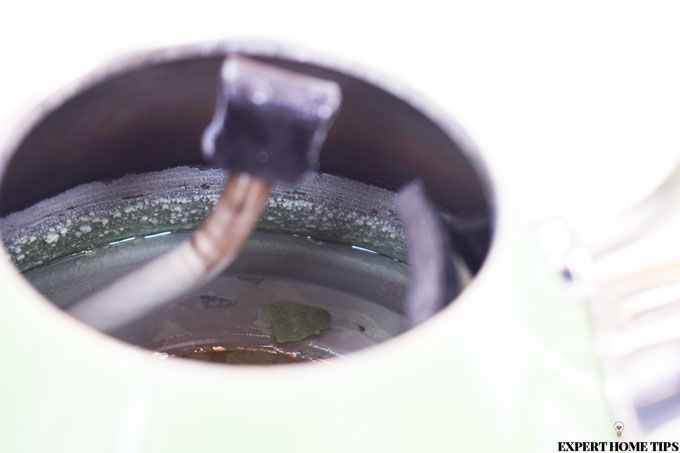
Limescale is a white deposit that's also known as calcium carbonate - it's the reason your kettle needs regular cleaning.
Limescale is found in places where hot water has evaporated and some of the remaining deposit has solidified. You might have also seen it on old pipes, water tanks, and central heating systems. It's especially common in hard water areas because the water is high in dissolved magnesium and calcium.
How often should you clean your kettle?
Your kettle needs cleaning and descaling regularly. We recommend that you:
- Clean the outside of the kettle once a fortnight, or as needed.
- Treat limescale once a month - if you live in a hard water area, you might want to do this more frequently.
How to descale your kettle
1. Descale your kettle with vinegar
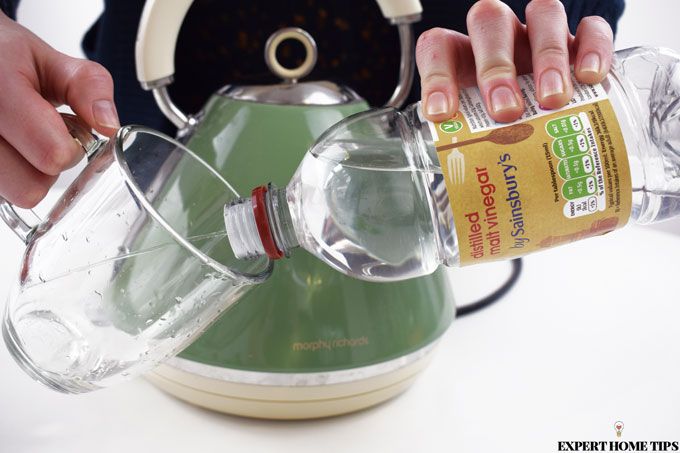
- Start by filling your kettle to the maximum line with equal parts water and white vinegar. Note: If your kettle has a lot of limescale buildup, the acid in the vinegar will react with the alkaline residue, creating bubbles. You may only want to half-fill the kettle to prevent overflowing.
- Boil the kettle and leave the mixture to soak for an hour.
- Pour out the mixture and rinse the inside of the kettle with clean water.
- If the limescale remains, repeat the process. You could add more vinegar than water depending on the severity of the limescale.
- If there is still some limescale, use a sponge or cloth to gently scrub it off. Don't scrub at the heating element or you could damage your kettle.
- Rinse and boil the kettle with clean water until the smell is gone.
TOP TIP: Make sure to unplug the kettle or inform everyone in your household that you're in the middle of cleaning, or they could be left with a bad taste in their mouth!
2. How to use lemon to descale your kettle
- Fill your kettle with clean water to just below the maximum line.
- Squeeze the juice of a lemon into the kettle.
- Cut up the remaining lemon into smaller pieces and add to the water.
- Boil the kettle with the lemon and water inside. Leave the mixture to soak for 1 hour.
- Rinse the kettle with clean water, making sure to remove any remaining lemon.
3. Using bicarbonate of soda to clean a kettle
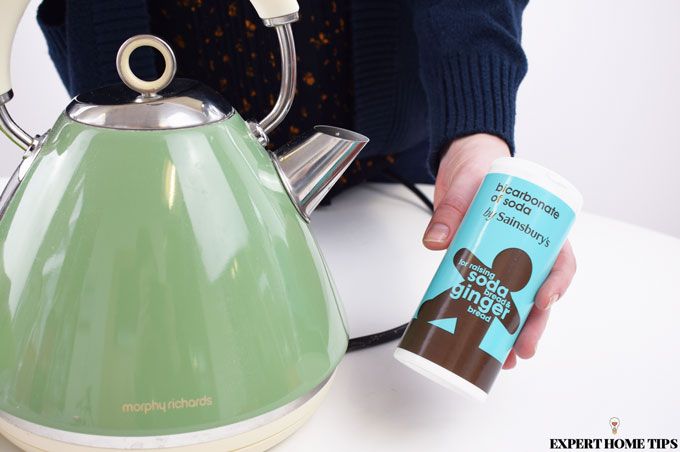
- After following any of the above methods, you could take an extra step and sprinkle a few tablespoons of baking soda into the kettle.
- Leave the baking soda to sit at the base for a few minutes.
- Use a soft cloth to wipe the inside of the kettle clean and then rinse.
TOP TIP: You can also use baking soda in place of lemon or vinegar. Use approximately 2 tablespoons stirred into a full kettle of clean water and bring to boil.
4. Will coco cola descale a kettle?
Most of us will have heard of the wondrous cleaning powers of coca cola, but did you know that it can also be used to descale your kettle? It contains carbonic acid, which is really powerful when it comes to fighting limescale.
- Fill your kettle with coca cola and boil.
- Leave to stand for 30 minutes.
- Rinse thoroughly to remove any smells.
5. How to clean a kettle with citric acid
Citric acid can be bought for use as a commercial cleaning ingredient. It is best known for its descaling properties. It's no wonder that people love to use it to clean their kettles, dishwashers, washing machines and more!
To use citric acid on your kettle, follow these steps:
- Fill your kettle until it's about halfway full.
- Boil the kettle and then unplug it from the power source.
- Add 2 tablespoons of citric acid to the water inside of the kettle.
- Use the spoon to stir the powder into the water. Take care, it will be hot!
- Leave the mixture to sit in your kettle for at least 20 minutes.
- Once 20 minutes have passed, empty the mixture out and rinse the kettle.
6. Clean the filter
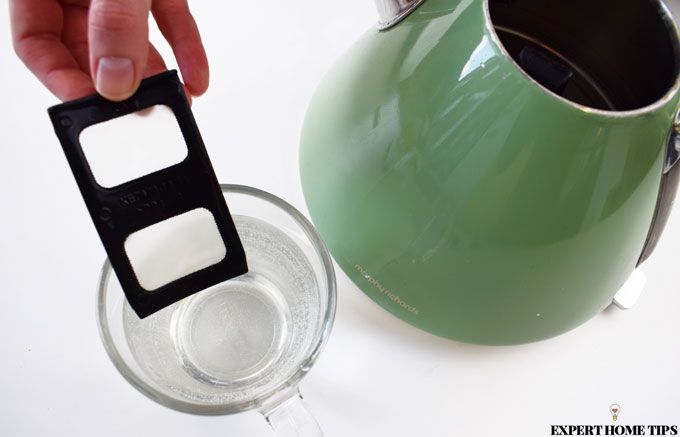
Don't forget to clean your filters. A lot of limescale gets caught up here!
- If the filter is removable, pop it in a glass of white vinegar for 20 minutes.
- Use a scrubber to clean off any limescale.
How to clean the outside of your kettle
Cleaning the outside of your kettle should be done more regularly than descaling. You should try to do it at least every fortnight to remove any grime or marks.
- Spray a cloth with an antibacterial, multi-purpose cleaner.
- Wipe the kettle to remove residue.
- For stainless steel kettles, you can use baby oil or olive oil to give it a sparkling, streak-free finish. Just buff in a small amount with a clean, dry cloth.
- Make sure to clean the spout after you've descaled the kettle. The steam from boiling the kettle will have worked it's magic to loosen up the limescale - it'll just need a quick wipe.
TOP TIP: If you're cleaning an electric kettle, take care to keep the electrical elements and sockets dry at all times.
Preventing limescale buildup in the future
1. Don't overfill your kettle
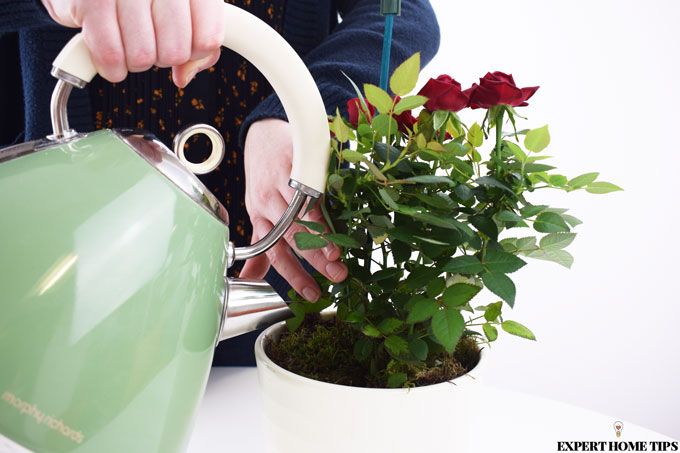
Standing water leads to deposits over time. Leave remaining water to cool and then pour onto plants to stop it going to waste.
2. Filter your water
You might be able to reduce deposits by only filling your kettle with water that has been filtered, or by using a kettle that has a filter in it. Kettles with built-in filters might not filter your water, but they will stop limescale flakes from going into your drinks!
3. Keep up with regular cleaning
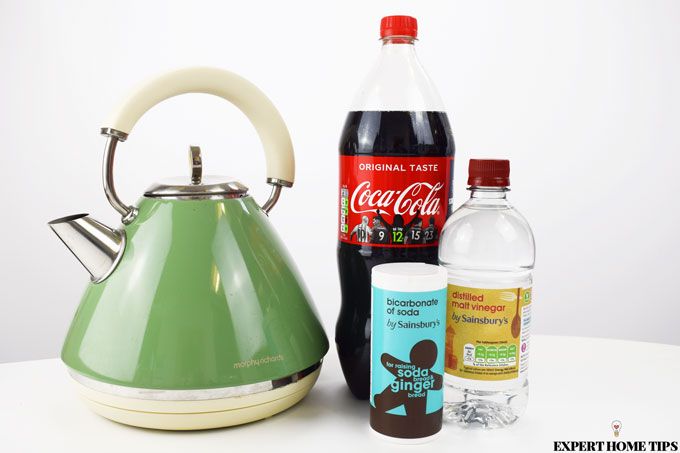
Even if your kettle looks clean and limescale free, prevention is always the best method. Make sure to keep up with regular cleaning so that you don't end up overwhelmed with a difficult deep clean.
4. Get a kettle descaling ball
These nifty little wire balls can be popped into your kettle to ensure that limescale is collected before it has a chance to settle at the bottom. You can remove the ball periodically to rinse off the limescale and reuse.
Now that you know how to remove limescale in a kettle, find out how to remove toilet limescale. It's a slightly different process.
Q&A
How do you get rid of the metal taste in a kettle?
It's quite normal to experience a metallic taste from a brand new kettle. Normally this will go away over time and if you boil a few kettles full of water first. If the metallic taste lingers, try using the bicarbonate of soda method listed above.
Can you boil an egg in a kettle?
You certainly can! This fun hack isn't the most practical idea because, if the egg cracks, you'll have quite the cleaning job on your hands. It's also not advised to drink the water that the eggs have cooked in, as you don't know what debris might come loose from the shells! We'd stick to a pan on the stove if we were you.
What happens if I boil an empty kettle?
This depends on the kettle but, with an older model, you could end up damaging the heating element. Some kettles will automatically switch off if there is no water inside. This is an added safety feature.
Can I remove rust from a cast iron kettle?
We have a handy guide that'll help you to remove rust from anywhere and everywhere, and cast iron kettles are no exception! Coca-cola is particularly good for removing rust, so give that a go.
How much does it cost to boil a kettle of water?
According to Npower, the average kettle costs 2p to boil.
Can I use these tips on a plastic kettle?
Yes - these tips are equally suited to use on a plastic kettle.
Have you got any more handy hints for cleaning your kettle? Let us know in the comments below!

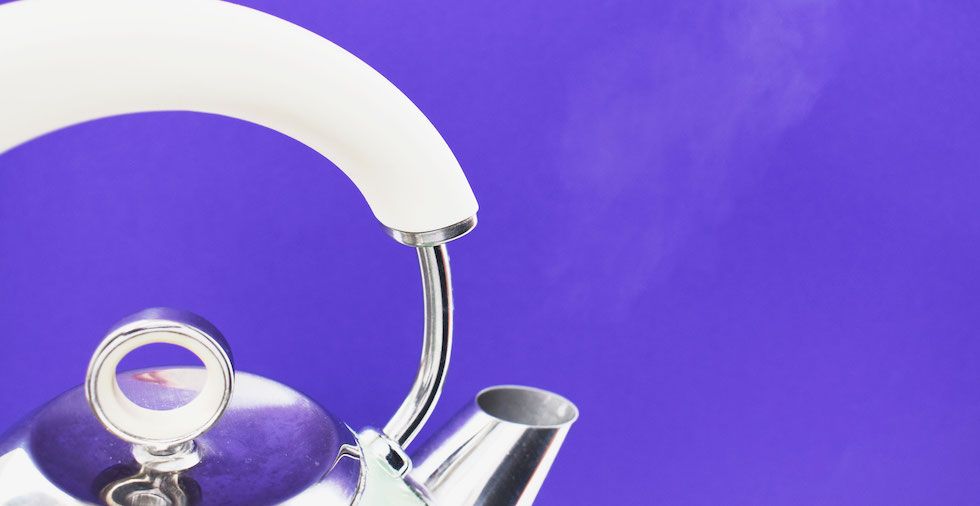
Citric acid is also very effective.
Thanks for sharing, Damasa!
Very important to boil only the amount of water you need - kettles use a surprising amount of electricity to work so quickly, which means 2 things - it costs a lot and more importantly - it causes CO2 to be produced. A sensible thing to do is measure the amount of water you need in the mug then pour it into the kettle...
That's a great idea, Alison!
My preferred option is citric acid, it leaves less of a smell and less of a taste than vinegar, two teaspoons and fill the kettle to about half way with filtered water, leave the wire balls in, bring it to the boil and let it do its thing, everything comes out spotless. Afterwards, half fill the kettle again with filtered water and boil it through to remove any remaining acid otherwise, if you have milk in your tea or coffee it is likely to curdle. In response to Alison's comment, many kettles these days have a "Minimum" mark, so measuring out water before is not always an option, plus, if your kettle allows it, it would be wise to measure out slightly more than you need, to compensate for water vapour loss and to prevent the kettle from boiling dry. Another option, if you only want a cup full or a mug full of water, you can get water boilers that deliver just that amount of water, the cup or mug is placed on a drip tray underneath the spout. We bought one for my elderly mother-in-law, much safer than her trying to maneuver a boiling kettle and it only heats the amount of water she needs.
Great tips! I'll give citric acid a try next time my kettle needs a clean.
i have tried vinagar overnight then boiled kettle still same scale i tried baking soda in hot water for 1/2 hoius than boiled, still scale what next? Is citric acide stronger than vviaiger water & baking soad I cant relly get my hand in to scrub it weel and worry about ehtaing elelmenst
It can be really hard to get the scale off the heating element. We prefer natural methods, but it might be worth trying a chemical kettle cleaner?
Is it safe to use coca cola? Won't it boil over everywhere? Should it be flat (no bubbles) before you boil it in your kettle?
Hi Rosemary! As long as you don't go past the max line on your kettle, it won't boil over. I have tried this and just used regular coke but, if you have flat coke going to waste, this could work too. I'm not sure if it would work as well though, as the carbonation would be lost.
Citric acid works the best. Add it to cold water and heat it as necessary. Adding it to hot water will create foam that can overflow the container or spray into the face. Impressive but unnecessary. Trace amount of citric acid left will not affect anything. Cola has a mixture of acids, phosphoric, citric and carbonic (gas). But sugars and colorants can stain the kettle, and overall it is a waste if acid is all that is needed. Small amounts of water can be heated in a kettle with a flat heating element (most of them), and not necessarily to the boiling point. I often heat just slightly more than 1 mug. It may not shut off until enough steam is created or allowed to escape by removing the filter grille.
Can any one explain how to get rid of the lime scale caught in the water gauge on the outside of a kettle?
Remove the limescale from the water gauge on the outside of a kettle by mixing equal parts white vinegar and water in it, bring it to a boil, turn off the heat and let it sit for an hour before scrubbing the gauge with a brush. Another option is to use a descaling solution specifically designed for removing limescale from kettles, following the instructions on the product's label.
I used every alternatives to remove kettle lime scale, all are effective. I thank you so much for help and knowledge. And I have a question on industrial boiler lime scale, how it can be perform.
We're so glad you found it helpful! Limescale buildup in industrial boilers can be removed through a process called descaling which can be done by chemical descaling, mechanical descaling, or a combination of both. It is essential that descaling should be performed by trained professionals who are familiar with the equipment and the proper methods for descaling.
Citric acid seems to be a popular item among your respondents, I've been using citric acid and bicarb for years for all sorts of cleaning (distilled vinegar too - but not for kettles) and, if bought in bulk, is a cheap option. Just do an internet search for it, I tend to get mine from Amazon but, of course, other outlets are available, similarly with bicarb. I fill smaller containers e.g. cleaned and recycled jars with their lids (screw top jam jars, chutney jars - whatever I have available) with each and leave the bulk sealed until I need to refill the jars. Reusing glass jars and using cheap, environmentally friendly (i.e. no harsh chemicals) cleaning products - what's not to like?
We agree!
I normally just tip it upside down with clear water, but I will try the bicarbonate method next time.
That's an interesting idea!
Hi i have tried vinegar and bicarp and also lemon and boiled this kettle nimerious times with this and nothing worked. The limescale does not come of.. And now i want to know is it okay to use boraks powder in my kettle to clean it.
I'm sorry to hear that, Martie! You must have some tough limescale. Are you referring to Borax powder? You can use that to clean a kettle. To use it, mix a small amount of borax powder with water to form a paste, and then apply the paste to the inside of the kettle. Scrub the kettle with a brush or sponge, then rinse it thoroughly with water. Be aware that Borax is toxic when ingested, so rinse thoroughly.
Hi, I have a one cup /hot cup type of kettle where the water enough for a cup at a time goes into a small area in the lower part of the kettle in order to save boiling more than you need. As it’s a sealed area how can I clean the kettle where the water boils? Thanks ?
To clean your one-cup hot water dispenser kettle, mix equal parts white vinegar and water, fill the kettle, and run a boiling cycle. Let the vinegar solution sit for 1-2 hours, then scrub the interior with a cloth or brush. Rinse thoroughly and consult the manufacturer's guide for specific cleaning instructions.